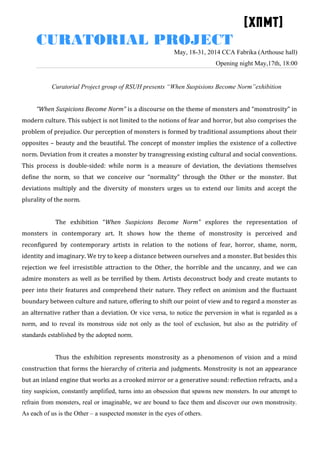When-suspicions-become-norm
•Download as DOC, PDF•
0 likes•108 views
The exhibition "When Suspicions Become Norm" explores how contemporary artists represent monsters and the concept of monstrosity in modern culture. It shows how artists reconfigure notions of fear, horror, shame, norms, identity, and the imaginary through their depictions of monsters. The exhibition aims to reveal how perceptions of monsters define norms and standards, yet deviations from the norm also help shape it. By deconstructing the body and creating mutants, artists seek to understand monsters and shift perspectives so monsters are seen as alternatives rather than deviations.
Report
Share
Report
Share

Recommended
Recommended
More Related Content
Similar to When-suspicions-become-norm
Similar to When-suspicions-become-norm (16)
WAYS OF SEEINGbases on the BBC television series with.docx

WAYS OF SEEINGbases on the BBC television series with.docx
1 Roger Scruton BEAUTY. A Very Short Introduction, O.docx

1 Roger Scruton BEAUTY. A Very Short Introduction, O.docx
When-suspicions-become-norm
- 1. CURATORIAL PROJECT May, 18-31, 2014 CCA Fabrika (Arthouse hall) Opening night May,17th, 18:00 Curatorial Project group of RSUH presents “When Suspisions Become Norm”exhibition “When Suspicions Become Norm” is a discourse on the theme of monsters and “monstrosity” in modern culture. This subject is not limited to the notions of fear and horror, but also comprises the problem of prejudice. Our perception of monsters is formed by traditional assumptions about their opposites – beauty and the beautiful. The concept of monster implies the existence of a collective norm. Deviation from it creates a monster by transgressing existing cultural and social conventions. This process is double-sided: while norm is a measure of deviation, the deviations themselves define the norm, so that we conceive our “normality” through the Other or the monster. But deviations multiply and the diversity of monsters urges us to extend our limits and accept the plurality of the norm. The exhibition “When Suspicions Become Norm” explores the representation of monsters in contemporary art. It shows how the theme of monstrosity is perceived and reconfigured by contemporary artists in relation to the notions of fear, horror, shame, norm, identity and imaginary. We try to keep a distance between ourselves and a monster. But besides this rejection we feel irresistible attraction to the Other, the horrible and the uncanny, and we can admire monsters as well as be terrified by them. Artists deconstruct body and create mutants to peer into their features and comprehend their nature. They reflect on animism and the fluctuant boundary between culture and nature, offering to shift our point of view and to regard a monster as an alternative rather than a deviation. Or vice versa, to notice the perversion in what is regarded as a norm, and to reveal its monstrous side not only as the tool of exclusion, but also as the putridity of standards established by the adopted norm. Thus the exhibition represents monstrosity as a phenomenon of vision and a mind construction that forms the hierarchy of criteria and judgments. Monstrosity is not an appearance but an inland engine that works as a crooked mirror or a generative sound: reflection refracts, and a tiny suspicion, constantly amplified, turns into an obsession that spawns new monsters. In our attempt to refrain from monsters, real or imaginable, we are bound to face them and discover our own monstrosity. As each of us is the Other – a suspected monster in the eyes of others.